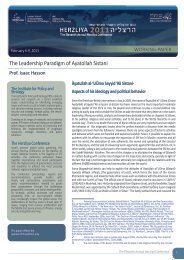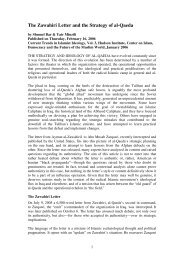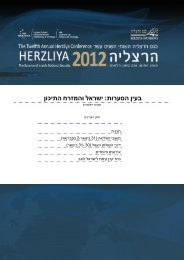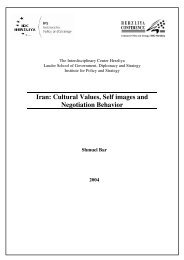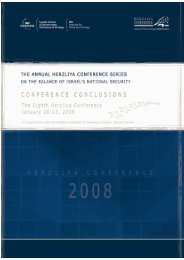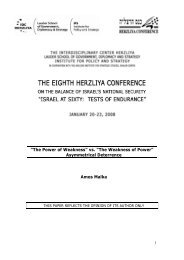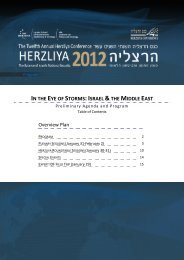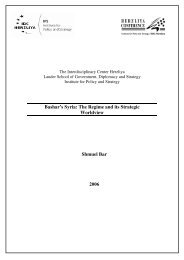Classical Islamic Paradigms of Deterrence and their Expression in ...
Classical Islamic Paradigms of Deterrence and their Expression in ...
Classical Islamic Paradigms of Deterrence and their Expression in ...
You also want an ePaper? Increase the reach of your titles
YUMPU automatically turns print PDFs into web optimized ePapers that Google loves.
political nature which the former did not wish the latter to do." Dur<strong>in</strong>g the era <strong>of</strong> the Cold War deterrenceas a strategic policy was only mean<strong>in</strong>gful if "the strategic <strong>in</strong>strument [nuclear arms] upon which it relies willnot be called upon to function at all." 27 Historically seen, however, deterrence is a very dynamicphenomenon. <strong>Deterrence</strong> by denial through <strong>in</strong>timidation is one <strong>of</strong> the oldest human defense mechanisms.In fact, deterrence can be seen as one <strong>of</strong> the most basic social patterns <strong>and</strong> phenomena <strong>of</strong> mank<strong>in</strong>d,besides government, warfare, trade <strong>and</strong> alliances. "The exact antiquity <strong>of</strong> deterrence may never be knownwith high precision, but a term<strong>in</strong>us ante quem <strong>of</strong> 7500-5000 B.C. seems solid. This means that deterrencecould have emerged much earlier; we just have no way to detect it. Similar to warfare, deterrence probablydeveloped from primordial skills <strong>of</strong> strategic <strong>in</strong>teraction, <strong>and</strong> it was selectively acquired by hunter-gatherergroups prior to the rise <strong>of</strong> organized polities with centralized authority (chiefdoms <strong>and</strong> states). However,evidence <strong>of</strong> deterrence became only later visible through fortifications (deterrence by denial) <strong>and</strong>eventually through epigraphy (deterrence by punishment)." 28 The first epigraphic evidence for deterrenceby punishment dates from the border-conflict between the Sumerian city-states Umma <strong>and</strong> Lagash around2450 BC: "Do not attempt to threaten our city’s surround<strong>in</strong>g l<strong>and</strong>s or we shall launch an army to destroyyou." (Lagash to Umma, ca. 2450 B.C.). 29 Let us call to m<strong>in</strong>d B<strong>in</strong> Laden’s speeches, for example, <strong>in</strong> October2011: "As to America, I say to it <strong>and</strong> its people a few words: I swear to God that America will not live <strong>in</strong>peace before peace reigns <strong>in</strong> Palest<strong>in</strong>e, <strong>and</strong> before all the army <strong>of</strong> <strong>in</strong>fidels depart the l<strong>and</strong> <strong>of</strong> Mohammad,peace be upon him."30 Other threats have characterized B<strong>in</strong> Laden’s speeches, such as: "God will<strong>in</strong>g, ourattacks aga<strong>in</strong>st you will cont<strong>in</strong>ue as long as you ma<strong>in</strong>ta<strong>in</strong> your support to Israel."31 Root patterns <strong>of</strong>deterrence, however, developed already <strong>in</strong> pre-historic times. Hom<strong>in</strong>ids probably gathered <strong>in</strong> groups <strong>in</strong> theopen grass-l<strong>and</strong>s <strong>of</strong> Africa several million years ago <strong>and</strong> developed collective stomp<strong>in</strong>g, shout<strong>in</strong>g <strong>and</strong><strong>in</strong>timidation rituals <strong>in</strong> order to deter enemies (large predators <strong>and</strong> other groups). The need to deter wasone <strong>of</strong> the most effective group-build<strong>in</strong>g mechanisms, which allowed hom<strong>in</strong>ids to switch from <strong>in</strong>dividual tocollective awareness <strong>and</strong> organize themselves. 32Yet, Cold War deterrence paradigms (WMD, second strike; Mutually Assured Destruction) overshadow untiltoday evolutionary-biological <strong>and</strong> tribal deterrence patterns. After a long st<strong>and</strong>still <strong>in</strong> the formulation <strong>of</strong>deterrence policies, "the concept <strong>of</strong> deterrence has lately been mak<strong>in</strong>g someth<strong>in</strong>g <strong>of</strong> a comeback <strong>in</strong>Western strategic circles." However, John Stone concludes that "it would be a grave mistake to assume thatconventional deterrence can reclaim anyth<strong>in</strong>g like the strategic centre-stage that nuclear deterrenceoccupied dur<strong>in</strong>g the Cold War." 33 Stone may be right, but that does not justify any negligence towardsother possible means <strong>of</strong> deterrence. Accord<strong>in</strong>gly "concepts used <strong>in</strong> modern theories <strong>of</strong> deterrence tend t<strong>of</strong>ocus on the relationship between states, <strong>and</strong> on the high end <strong>of</strong> potential conflict. For example,confrontation between regular armies or nuclear conflict between states. These theories naturallyovershadowed traditional descriptions <strong>of</strong> coercion – deterrence <strong>and</strong> compellence – which have existeds<strong>in</strong>ce time immemorial for deterrence relations between states as well as between states <strong>and</strong> non-state(<strong>in</strong>surgents, guerillas, terrorists). The relationship between a state (Israel) <strong>and</strong> non-state terroristorganizations is, by nature, asymmetric. This asymmetry makes doctr<strong>in</strong>es <strong>of</strong> deterrence, which were27 Bernard Brody, "The Anatomy <strong>of</strong> <strong>Deterrence</strong>," U.S. Air Force R<strong>and</strong> Compendium RM 2218, July 23, 1958, p. 8.28 Claudio Ci<strong>of</strong>fi-Revilla, "Orig<strong>in</strong>s <strong>and</strong> Age <strong>of</strong> <strong>Deterrence</strong>: Comparative Research on Old World <strong>and</strong> New World Systems," Cross CulturalResearch 33, 1999 p. 257.29 Ibid, p. 242.30 "Statement <strong>of</strong> Osama B<strong>in</strong> Laden through a spokesman, aired on Al-Jazeera TV, after the the US bomb<strong>in</strong>g <strong>of</strong> Afghanistan began,"(Accessed July 7, 2012) - http://www.mideastweb.org/osamab<strong>in</strong>laden3.htm31 "New b<strong>in</strong> Laden speech says climate change is worse than wars," (Accessed July 3, 2012)-http://www.nypost.com/p/news/<strong>in</strong>ternational/new_b<strong>in</strong>_laden_speech_says_climate_UPvTwnnopR0jaWzwoXgfjL32 Joseph Jordania, "Why do Humans S<strong>in</strong>g? Music <strong>in</strong> Human Evolution", Logos, 2011.33 John Stone, "Conventional <strong>Deterrence</strong> <strong>and</strong> the Challenge <strong>of</strong> Credibility, "Contemporary Security Policy, 33:1, April 2012, pp. 108–123.11



